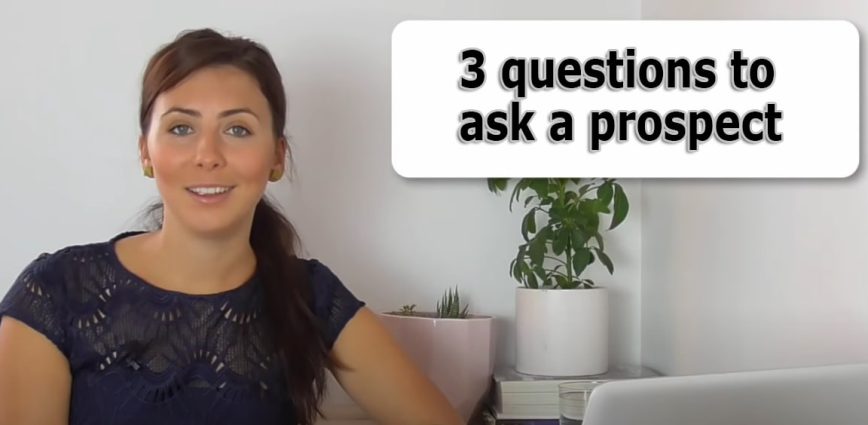Literally, time is money. It is essential that business professionals make efficient use of their time in order to capitalize on the many possibilities that present themselves on a daily basis. This indicates that you need to spend as little time as possible on laborious chores, since doing so prevents you from engaging in conversation with prospective customers who are qualified.
At this point, the ability to immediately qualify or reject a prospect is one of the most crucial skills to have. Your potential customers have a full schedule just like you do, so they will be relieved to learn that you will not waste their time by attempting to sell them something that they do not want or desire. You can decide who is a suitable match for the role based on their answers to the following three important questions.
Question 1: An Outline of Everything
The first question used to determine eligibility should be something along these lines:
“In the past, we have worked with businesses that are quite comparable to yours, and I would like to demonstrate the solution that we developed for them to you.” I was wondering if it was anything you may be interested in looking into.
This not only guarantees that they are interested in what you have to offer but also opens the door for you to explain the product or service in further detail. If they respond “yes,” then you are allowed to go with providing an overview of how you are able to assist them and giving them a timetable of how long you estimate it to take to execute the solution.
If they do not respond “yes,” then you are unable to proceed. You want to convince the prospective client that you have precisely what they are searching for and that you give greater value than your rivals via this. Your goal is to build confidence in the possible consumer that you have what they are looking for.
If they respond with a “no,” you will at least be able to spare both parties some time. After that, you have the option of inquiring as to the reason(s) why they are not interested in your solution and determining the areas in which you can improve.
If they don’t offer you anything to build off of when they ask the follow-up questions, you won’t have much area for maneuvering moving forward since this is the first question that qualifies you for the position.
Question 2: What is the Strategy? The Plan
After demonstrating to the prospective customer what your service is capable of, the next step is to explain out how you intend to modify it to meet their specific requirements in as much detail as possible. The second question that qualifies candidates need to be something along these lines:
Would you be interested, now that you have seen what our solution is capable of doing on a broad scale, in seeing what we can do to cater to your particular requirements?
Again, this is a fairly generic question, but you want to make sure that both sides are ready to go ahead in the process and are on the same page.
If they respond with a “yes,” you can then continue to spell out your solution and how you are going to personalize it to their requirements based on the findings you have accumulated up until this point. After that, you may investigate more to find out what else you can do to assist in making the process go well. You now have the opportunity to show that you have experience working with other customers by stating something along the lines of “some of our customers love when we…., is this something that you would be interested in?”
If they respond with a “no,” then you have the opportunity to reconsider and investigate the reasons behind their decision. Perhaps they are still concerned about something from the first inquiry, or perhaps now is not the appropriate moment for their organization. Both of these possibilities are possible. Asking some exploration questions can help you figure out where you can go from there, regardless of the answer you get.
Question 3 – Lastly a final check
You should have at this point outlined the full plan, tailored specifically to the requirements of the customer, as well as a timeframe for the amount of time it will take to install and get used to making use of the product or service. You are going to want to perform one last check to ensure that everything is understandable to the customer and to determine whether or not there are any unanticipated adjustments that need to be made.
In the event that there are certain alterations that need to be done, a question along these lines may be posed:
“Certain of the variables that were included into our strategy have evolved, and as a result, we need to make some modifications in order to remain on schedule. Are you prepared to collaborate with me to ensure that we do not deviate from our plan?
If they respond with a “yes,” then that’s fantastic news; you’ll be able to smooth out any bumps in the road ahead of you to make sure the transfer is seamless and the deadline is kept. Because you have both worked together for a sufficient amount of time at this point to have developed a mutual trust in the partnership, it is quite likely that they will be willing to collaborate with you on it.
If they respond with a “no,” you will need to decide if the lead is delayed or whether it has been lost. In the event that the lead is delayed, you will still be in a position to qualify the offer; however, it is possible that now is not the best moment for your customer. At this point, the customer is aware of all that your company has to offer; they are also aware of the value that your solution provides, and as a result, they may be inclined to return at a later time.
However, if the lead is dead, there is no meaningful way to go ahead other than to figure out what the prospect saw as the single most important factor in making their decision. You will have an opportunity to become better for the subsequent one.



